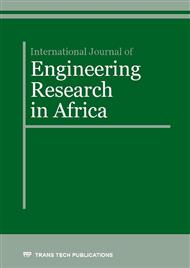[1]
L. S. Nielsen, Building Integrated System Design for Sustainable Heating and Cooling, REHVA J., no. February, p.24–27, (2012).
Google Scholar
[2]
P. Vangtook and S. Chirarattananon, Application of radiant cooling as a passive cooling option in hot humid climate, Build. Environ., vol. 42, no. 2, p.543–556, Feb. (2007).
DOI: 10.1016/j.buildenv.2005.09.014
Google Scholar
[3]
R. D. Watson and K. S. Chapman, Radiant Heating and Cooling handbook. McGraw-Hill, (2002).
Google Scholar
[4]
Uponor Inc, UPONOR Radiant Cooling Design Manual, 1st ed. Apple Vallley MN: Uponor, Inc., (2013).
Google Scholar
[5]
A. S. Binghooth and Z. a. Zainal, Performance of desiccant dehumidification with hydronic radiant cooling system in hot humid climates, Energy Build., vol. 51, p.1–5, Aug. (2012).
DOI: 10.1016/j.enbuild.2012.01.031
Google Scholar
[6]
A. Hamza, I. M. S. Taha, and I. M. Ismail, Cooling of water flowing thorugh a night sky radiator, Sol. Energy, vol. 55, no. 4, (1995).
DOI: 10.1016/0038-092x(95)00030-u
Google Scholar
[7]
A. H. H. Ali, Passive cooling of water at night in uninsulated open tank in hot arid areas, Energy Convers. Manag., vol. 48, no. 1, p.93–100, Jan. (2007).
DOI: 10.1016/j.enconman.2006.05.012
Google Scholar
[8]
P. D. Dan and J. C. V. Chinnappa, The Cooling Of Water Flowing Over An Inclined Surface Exposed To The Night Sky, Sol. Wind Technol., vol. 6, no. 1, p.41–50, (1989).
DOI: 10.1016/0741-983x(89)90036-2
Google Scholar
[9]
N. Chotivisarut, A. Nuntaphan, and T. Kiatsiriroat, Seasonal cooling load reduction of building by thermosyphon heat pipe radiator in different climate areas, Renew. Energy, vol. 38, no. 1, p.188–194, Feb. (2012).
DOI: 10.1016/j.renene.2011.07.021
Google Scholar
[10]
T. Runsheng, Y. Etzion, and E. Erell, Experimental studies on a novel roof pond configuration for the cooling of buildings, Renew. Energy, vol. 28, no. 10, p.1513–1522, Aug. (2003).
DOI: 10.1016/s0960-1481(03)00002-8
Google Scholar
[11]
E. Erell and Y. Etzion, Radiative cooling of buildings with flat-plate solar collectors, Build. Environ., vol. 35, no. 4, p.297–305, May (2000).
DOI: 10.1016/s0360-1323(99)00019-0
Google Scholar
[12]
J. Sima, O. Sikula, K. Kosutova, and J. Plasek, Theoretical Evaluation of Night Sky Cooling in the Czech Republic, Energy Procedia, vol. 48, p.645–653, (2014).
DOI: 10.1016/j.egypro.2014.02.075
Google Scholar
[13]
G. Heidarinejad, M. Farmahini, and S. Delfani, Investigation of a hybrid system of nocturnal radiative cooling and direct evaporative cooling, Build. Environ., vol. 45, no. 6, p.1521–1528, (2010).
DOI: 10.1016/j.buildenv.2010.01.003
Google Scholar
[14]
S. Zhang and J. Niu, Cooling performance of nocturnal radiative cooling combined with microencapsulated phase change material (MPCM) slurry storage, Energy Build., vol. 54, p.122–130, Nov. (2012).
DOI: 10.1016/j.enbuild.2012.07.041
Google Scholar
[15]
R. T. Dobson, Thermal modelling of a night sky radiation cooling system, J. Energy South Africa, vol. 16, no. 2, p.20–31, (2005).
DOI: 10.17159/2413-3051/2005/v16i2a3184
Google Scholar
[16]
J. a. Duffie and W. a. Beckman, Solar Engineering of Thermal Processes, 4th ed. New Jersey: Wiley, (2013).
Google Scholar
[17]
C. Cândido, R. J. De Dear, R. Lamberts, and L. Bittencourt, Air movement acceptability limits and thermal comfort in Brazil's hot humid climate zone, Build. Environ., vol. 45, p.222–229, (2010).
DOI: 10.1016/j.buildenv.2009.06.005
Google Scholar
[18]
S. H. Ibrahim and J. A. Tinker, Improvements to thermal comfort in low-income housing in Malaysia, in Conference on Sustainable Building South East Asia, (2005).
Google Scholar
[19]
S. Rajeh, Wind Ventilation of Terrace Housing in Malaysia, in ISI-UTM International Convention and Exposition, (1994).
Google Scholar
[20]
H. M. Kamar, N. Kamsah, M. M. Tap, and K. A. M. Salimin, Assessment of thermal comfort in a naturally ventilated residential terrace house, in The 4th International Meeting of Advances in Thermofluids (IMAT 2011), 2012, vol. 1440, no. 2012, p.247.
DOI: 10.1063/1.4704224
Google Scholar
[21]
M. G. Normah, K. Y. Lau, and S. Mohd. Yusoff, Thermal analysis of Malaysian double storey housing - low/medium cost unit, in The 4th International Meeting of Advances in Thermofluids (IMAT 2011), 2012, vol. 1440, no. 1440, p.513–520.
DOI: 10.1063/1.4704257
Google Scholar
[22]
ANSI/ASHRAE, Standard 55-2013 Thermal Environmental Conditions for Human Occupancy, vol. 8400. (2013).
Google Scholar
[23]
ISO, EN ISO 7730 Ergonomics of the thermal environment — Analytical determination and interpretation of thermal comfort using calculation of the PMV and PPD indices and local thermal comfort criteria, 3rd ed. Switzerland: ISO, (2005).
DOI: 10.3403/30046382
Google Scholar
[24]
ASHRAE, Chapter 14 . Climatic Design Information, in ASHRAE Handbook Fundemental, 2014th ed., Atlanta: ASHRAE, 2014, p.1–43.
Google Scholar


